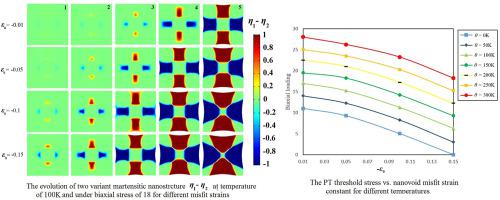当前位置:
X-MOL 学术
›
Mech. Mater.
›
论文详情
Our official English website, www.x-mol.net, welcomes your
feedback! (Note: you will need to create a separate account there.)
Nanovoid induced multivariant martensitic growth under negative pressure: Effect of misfit strain and temperature on PT threshold stress and phase evolution
Mechanics of Materials ( IF 3.4 ) Pub Date : 2020-12-01 , DOI: 10.1016/j.mechmat.2020.103627 Mahdi Javanbakht , Mohammad Sadegh Ghaedi
Mechanics of Materials ( IF 3.4 ) Pub Date : 2020-12-01 , DOI: 10.1016/j.mechmat.2020.103627 Mahdi Javanbakht , Mohammad Sadegh Ghaedi

|
Abstract In the present work, the effect of a pre-existing nanovoid on multivariant martensitic growth and in particular, on the phase transformation (PT) threshold stress, is investigated using the phase field approach. In order to create a pre-existing nanovoid in the model, a single nanovoid has been stabilized in the center of the computational domain using a phase field approach. The coupled Ginzburg-Landau and elasticity equations are solved to capture the evolution of martensitic nanostructure. The above systems of equations are solved using the finite element approach and the COMSOL code. Nanovoid-induced two variant martensitic growth under negative pressure is studied in detail. The PT threshold stress is found for different nanovoid misfit strain constants and different temperatures. The PT threshold stress increases linearly by increasing the temperature for any misfit strain which rate of increase is found the same for any misfit strain. For any temperature, the PT threshold stress nonlinearly decreases as the misfit strain constant increases. Under the applied negative pressure, both the first and the second variants grow from the nanovoid surface which evolutions are explained based on the distributions of the stress and transformation work. The martensitic growth is more pronounced for larger misfit strains due to higher stress concentrations. The martensitic nanostructure, stress distribution and the PT threshold stress are also found in the presence of a nano-hole for different temperatures and are compared to those of the nanovoid. The martensitic growth is also studied for different temperatures. As the temperature increases, the growth is slower and this is explained using the phase concentration for both the first and the second variants which increases nonlinearly and its growth rate nonlinearly varied vs time for any temperature. For larger temperatures, the phase concentration decreases and the growth rate decreases at the same phase concentration. A larger negative pressure is required for the martensitic growth at larger temperatures. The effect of sample size on the PT threshold stress was also investigated. The effect of mechanical driving force on the nanovoid-induced martensitic growth is studied by applying different negative pressures. As the negative pressure increases the growth exceedingly increases. The phase concentration evolution reveals the dependence of the growth on the loading magnitude so that for any loading, the phase concentration increases nonlinearly with a nonlinearly variable growth rate. As the loading increases, the phase concentration increases and the growth rate increases at the same phase concentration. Applying uniaxial loading results in nanovoid-induced single variant martensitic growth for which the PT threshold stress almost linearly decreases as the misfit strain constant increases. Comparing the results of the uniaxial loading and negative pressure shows that the PT threshold stress under uniaxial loading is approximately 1.6 times smaller than that under negative pressure for any misfit strain. The presented model and the obtained results will help to develop an interaction model between nanovoids and multiphase structure at the nanoscale.
中文翻译:

负压下纳米空隙诱导多元马氏体生长:错配应变和温度对 PT 阈值应力和相演变的影响
摘要 在目前的工作中,使用相场方法研究了预先存在的纳米空隙对多元马氏体生长的影响,特别是对相变 (PT) 阈值应力的影响。为了在模型中创建预先存在的纳米空隙,使用相场方法在计算域的中心稳定了单个纳米空隙。求解耦合的 Ginzburg-Landau 和弹性方程以捕捉马氏体纳米结构的演变。上述方程组使用有限元方法和 COMSOL 代码求解。详细研究了负压下纳米空隙诱导的两种变体马氏体生长。对于不同的纳米空隙错配应变常数和不同的温度,发现了 PT 阈值应力。通过增加任何失配应变的温度,PT 阈值应力线性增加,发现任何失配应变的增加率都相同。对于任何温度,PT 阈值应力随着失配应变常数的增加而非线性地降低。在施加的负压下,第一和第二变体都从纳米空隙表面生长,其演变基于应力和转变功的分布进行解释。由于较高的应力集中,对于较大的失配应变,马氏体生长更为明显。马氏体纳米结构、应力分布和 PT 阈值应力也在不同温度下存在纳米孔的情况下被发现,并与纳米空隙的那些进行比较。还研究了不同温度下的马氏体生长。随着温度升高,生长变慢,这可以使用第一和第二变体的相浓度来解释,其非线性增加,并且其生长速率随时间非线性变化,对于任何温度。对于较大的温度,相浓度降低,生长速率在相同相浓度下降低。在较高温度下马氏体生长需要较大的负压。还研究了样本大小对 PT 阈值应力的影响。通过施加不同的负压,研究了机械驱动力对纳米空隙诱导的马氏体生长的影响。随着负压的增加,增长极度增加。相浓度演变揭示了增长对加载幅度的依赖性,因此对于任何加载,相浓度以非线性可变增长率非线性增加。随着加载量的增加,相浓度增加,在相同的相浓度下生长速度增加。应用单轴加载导致纳米空隙诱导的单一变体马氏体生长,随着失配应变常数的增加,PT 阈值应力几乎线性降低。比较单轴加载和负压的结果表明,对于任何失配应变,单轴加载下的 PT 阈值应力比负压下的阈值应力小约 1.6 倍。所提出的模型和获得的结果将有助于在纳米尺度上开发纳米空隙和多相结构之间的相互作用模型。随着加载量的增加,相浓度增加,在相同的相浓度下生长速度增加。应用单轴加载导致纳米空隙诱导的单一变体马氏体生长,随着失配应变常数的增加,PT 阈值应力几乎线性降低。比较单轴加载和负压的结果表明,对于任何失配应变,单轴加载下的 PT 阈值应力比负压下的阈值应力小约 1.6 倍。所提出的模型和获得的结果将有助于在纳米尺度上开发纳米空隙和多相结构之间的相互作用模型。随着加载量的增加,相浓度增加,在相同的相浓度下生长速度增加。应用单轴加载导致纳米空隙诱导的单一变体马氏体生长,随着失配应变常数的增加,PT 阈值应力几乎线性降低。比较单轴加载和负压的结果表明,对于任何失配应变,单轴加载下的 PT 阈值应力比负压下的阈值应力小约 1.6 倍。所提出的模型和获得的结果将有助于在纳米尺度上开发纳米空隙和多相结构之间的相互作用模型。应用单轴加载导致纳米空隙诱导的单一变体马氏体生长,随着失配应变常数的增加,PT 阈值应力几乎线性降低。比较单轴加载和负压的结果表明,对于任何失配应变,单轴加载下的 PT 阈值应力比负压下的阈值应力小约 1.6 倍。所提出的模型和获得的结果将有助于在纳米尺度上开发纳米空隙和多相结构之间的相互作用模型。应用单轴加载导致纳米空隙诱导的单一变体马氏体生长,随着失配应变常数的增加,PT 阈值应力几乎线性降低。比较单轴加载和负压的结果表明,对于任何失配应变,单轴加载下的 PT 阈值应力比负压下的阈值应力小约 1.6 倍。所提出的模型和获得的结果将有助于在纳米尺度上开发纳米空隙和多相结构之间的相互作用模型。对于任何失配应变,比负压下的小 6 倍。所提出的模型和获得的结果将有助于在纳米尺度上开发纳米空隙和多相结构之间的相互作用模型。对于任何失配应变,比负压下的小 6 倍。所提出的模型和获得的结果将有助于在纳米尺度上开发纳米空隙和多相结构之间的相互作用模型。
更新日期:2020-12-01
中文翻译:

负压下纳米空隙诱导多元马氏体生长:错配应变和温度对 PT 阈值应力和相演变的影响
摘要 在目前的工作中,使用相场方法研究了预先存在的纳米空隙对多元马氏体生长的影响,特别是对相变 (PT) 阈值应力的影响。为了在模型中创建预先存在的纳米空隙,使用相场方法在计算域的中心稳定了单个纳米空隙。求解耦合的 Ginzburg-Landau 和弹性方程以捕捉马氏体纳米结构的演变。上述方程组使用有限元方法和 COMSOL 代码求解。详细研究了负压下纳米空隙诱导的两种变体马氏体生长。对于不同的纳米空隙错配应变常数和不同的温度,发现了 PT 阈值应力。通过增加任何失配应变的温度,PT 阈值应力线性增加,发现任何失配应变的增加率都相同。对于任何温度,PT 阈值应力随着失配应变常数的增加而非线性地降低。在施加的负压下,第一和第二变体都从纳米空隙表面生长,其演变基于应力和转变功的分布进行解释。由于较高的应力集中,对于较大的失配应变,马氏体生长更为明显。马氏体纳米结构、应力分布和 PT 阈值应力也在不同温度下存在纳米孔的情况下被发现,并与纳米空隙的那些进行比较。还研究了不同温度下的马氏体生长。随着温度升高,生长变慢,这可以使用第一和第二变体的相浓度来解释,其非线性增加,并且其生长速率随时间非线性变化,对于任何温度。对于较大的温度,相浓度降低,生长速率在相同相浓度下降低。在较高温度下马氏体生长需要较大的负压。还研究了样本大小对 PT 阈值应力的影响。通过施加不同的负压,研究了机械驱动力对纳米空隙诱导的马氏体生长的影响。随着负压的增加,增长极度增加。相浓度演变揭示了增长对加载幅度的依赖性,因此对于任何加载,相浓度以非线性可变增长率非线性增加。随着加载量的增加,相浓度增加,在相同的相浓度下生长速度增加。应用单轴加载导致纳米空隙诱导的单一变体马氏体生长,随着失配应变常数的增加,PT 阈值应力几乎线性降低。比较单轴加载和负压的结果表明,对于任何失配应变,单轴加载下的 PT 阈值应力比负压下的阈值应力小约 1.6 倍。所提出的模型和获得的结果将有助于在纳米尺度上开发纳米空隙和多相结构之间的相互作用模型。随着加载量的增加,相浓度增加,在相同的相浓度下生长速度增加。应用单轴加载导致纳米空隙诱导的单一变体马氏体生长,随着失配应变常数的增加,PT 阈值应力几乎线性降低。比较单轴加载和负压的结果表明,对于任何失配应变,单轴加载下的 PT 阈值应力比负压下的阈值应力小约 1.6 倍。所提出的模型和获得的结果将有助于在纳米尺度上开发纳米空隙和多相结构之间的相互作用模型。随着加载量的增加,相浓度增加,在相同的相浓度下生长速度增加。应用单轴加载导致纳米空隙诱导的单一变体马氏体生长,随着失配应变常数的增加,PT 阈值应力几乎线性降低。比较单轴加载和负压的结果表明,对于任何失配应变,单轴加载下的 PT 阈值应力比负压下的阈值应力小约 1.6 倍。所提出的模型和获得的结果将有助于在纳米尺度上开发纳米空隙和多相结构之间的相互作用模型。应用单轴加载导致纳米空隙诱导的单一变体马氏体生长,随着失配应变常数的增加,PT 阈值应力几乎线性降低。比较单轴加载和负压的结果表明,对于任何失配应变,单轴加载下的 PT 阈值应力比负压下的阈值应力小约 1.6 倍。所提出的模型和获得的结果将有助于在纳米尺度上开发纳米空隙和多相结构之间的相互作用模型。应用单轴加载导致纳米空隙诱导的单一变体马氏体生长,随着失配应变常数的增加,PT 阈值应力几乎线性降低。比较单轴加载和负压的结果表明,对于任何失配应变,单轴加载下的 PT 阈值应力比负压下的阈值应力小约 1.6 倍。所提出的模型和获得的结果将有助于在纳米尺度上开发纳米空隙和多相结构之间的相互作用模型。对于任何失配应变,比负压下的小 6 倍。所提出的模型和获得的结果将有助于在纳米尺度上开发纳米空隙和多相结构之间的相互作用模型。对于任何失配应变,比负压下的小 6 倍。所提出的模型和获得的结果将有助于在纳米尺度上开发纳米空隙和多相结构之间的相互作用模型。










































 京公网安备 11010802027423号
京公网安备 11010802027423号